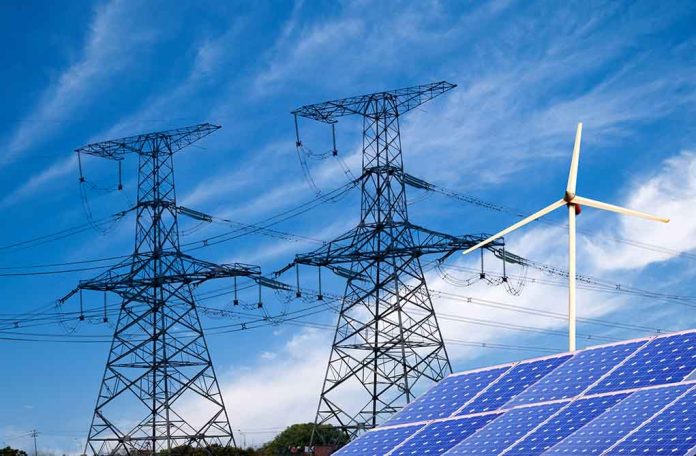
U.S. investigators have discovered hidden communication devices inside Chinese-made solar power inverters that could potentially allow Beijing to remotely disable America’s critical energy infrastructure during a conflict.
Key Takeaways
- Rogue communication devices with unauthorized cellular radios have been found inside Chinese solar power inverters connected to U.S. energy grids
- These hidden devices could potentially bypass firewalls and security measures, allowing remote access to critical infrastructure
- Former NSA analyst Rocky Cole warns this could be part of China’s broader strategy to create backdoors into American systems
- Nearly 50 vulnerabilities classified as high or critical severity have been identified in solar power systems from Chinese manufacturers
- China’s intelligence laws require Chinese companies to assist the government, raising additional security concerns
Hidden Threats in America’s Green Energy Infrastructure
U.S. energy officials have launched investigations into Chinese-manufactured components within America’s renewable energy infrastructure after discovering suspicious, undocumented communication devices embedded in critical equipment. These power inverters, which connect solar panels and wind turbines to electricity grids, contain hidden cellular radios and communication channels that were not disclosed to American purchasers or regulators. The discovery raises alarming questions about potential backdoors that could be exploited by foreign actors to disrupt or disable America’s power grid during times of conflict.
The unauthorized devices possess capabilities that could bypass firewalls and other security measures, potentially allowing Chinese operators to remotely access and control critical energy infrastructure components. As solar and wind power generation expands across the country, the increasing reliance on foreign-made equipment creates significant vulnerabilities in our national security architecture. These hidden components were only discovered during detailed security audits that are not standard practice for most energy infrastructure installations.
Unknown communication devices were found in Chinese-made solar inverters, batteries, EV chargers, and heat pumps. Experts say these rogue components could remotely shut down or damage U.S. power grid systems. The devices were discovered during routine security inspections over…
— Revere’s Midnight Ride (@PatriotLantern) May 27, 2025
National Security Experts Sound the Alarm
Rocky Cole, a former NSA analyst with expertise in cyber threats, has expressed serious concerns about the implications of these discoveries. Cole suggests that China may be methodically placing these backdoor access points into American infrastructure as part of a long-term strategy that could be activated during potential future conflicts. The critical nature of power inverters—which essentially serve as the brain connecting renewable energy sources to the electrical grid—makes them particularly valuable targets for anyone seeking to disrupt America’s energy security.
“While this functionality may not have malicious intent, it is critical for those procuring to have a full understanding of the capabilities of the products received,” a spokesperson said.
The Department of Energy is working to address these vulnerabilities through enhanced disclosure requirements, including Software Bill of Materials (SBOMs) that would provide greater transparency about the components and capabilities of imported energy equipment. However, critics argue that these measures may be insufficient given the scale of the problem and the sophisticated nature of the threats posed by state-sponsored actors with deep resources and long-term strategic objectives.
Growing Vulnerability in Critical Infrastructure
Research conducted by Forescout’s Vedere Labs has identified nearly 50 vulnerabilities in solar power systems from Chinese manufacturers including Huawei, Sungrow, and SMA Solar Technology. Many of these vulnerabilities are classified as high or critical severity, potentially allowing attackers to disrupt power generation, manipulate energy flow, or even cause physical damage to equipment. The widespread adoption of these vulnerable systems throughout America’s energy infrastructure creates a concerning attack surface that could be exploited during times of international tension.
Further complicating the situation is China’s National Intelligence Law, which requires Chinese companies to assist and cooperate with the country’s intelligence services when requested. This legal framework means that even if the manufacturers themselves had no malicious intent when designing their products, they could be legally compelled to provide access or assistance to Chinese intelligence agencies seeking to exploit these systems. Despite diplomatic denials from the Chinese Embassy emphasizing China’s peaceful development goals, the technical evidence and legal realities paint a more concerning picture.
Securing America’s Energy Future
The situation highlights a critical vulnerability in President Trump’s efforts to strengthen America’s energy independence and security. While the administration has championed domestic energy production, the reliance on foreign-manufactured components for renewable energy systems creates backdoor vulnerabilities that undermine those security goals. Experts recommend implementing strict oversight of supply chains for critical infrastructure components, conducting thorough security audits of existing installations, and accelerating efforts to develop domestic manufacturing capabilities for these essential technologies.
As the U.S. continues to modernize its energy grid, balancing the benefits of renewable energy with the security risks posed by foreign-manufactured components will remain a significant challenge. The discovery of these rogue communication devices serves as a stark reminder that in today’s interconnected world, energy security extends far beyond simply ensuring adequate supply—it must also address the integrity and trustworthiness of the physical and digital systems that deliver that energy to American homes and businesses.



